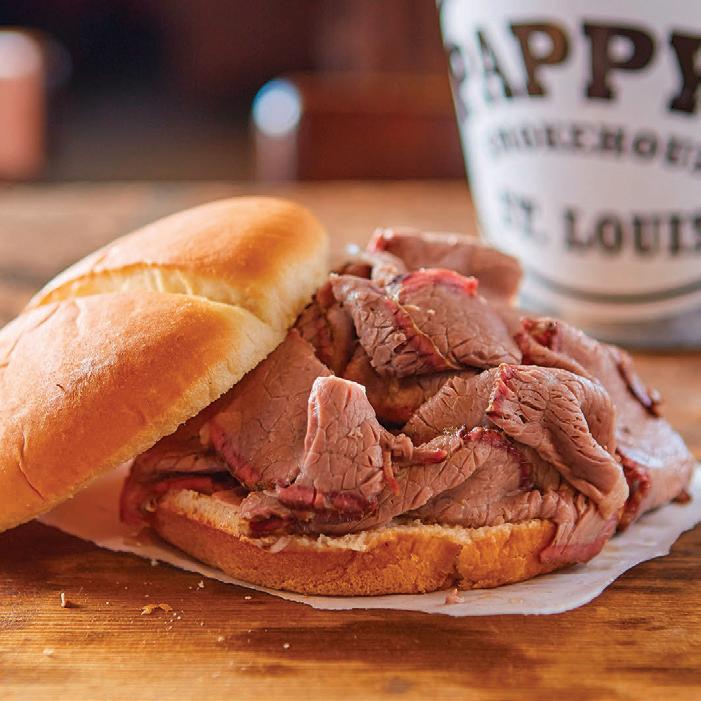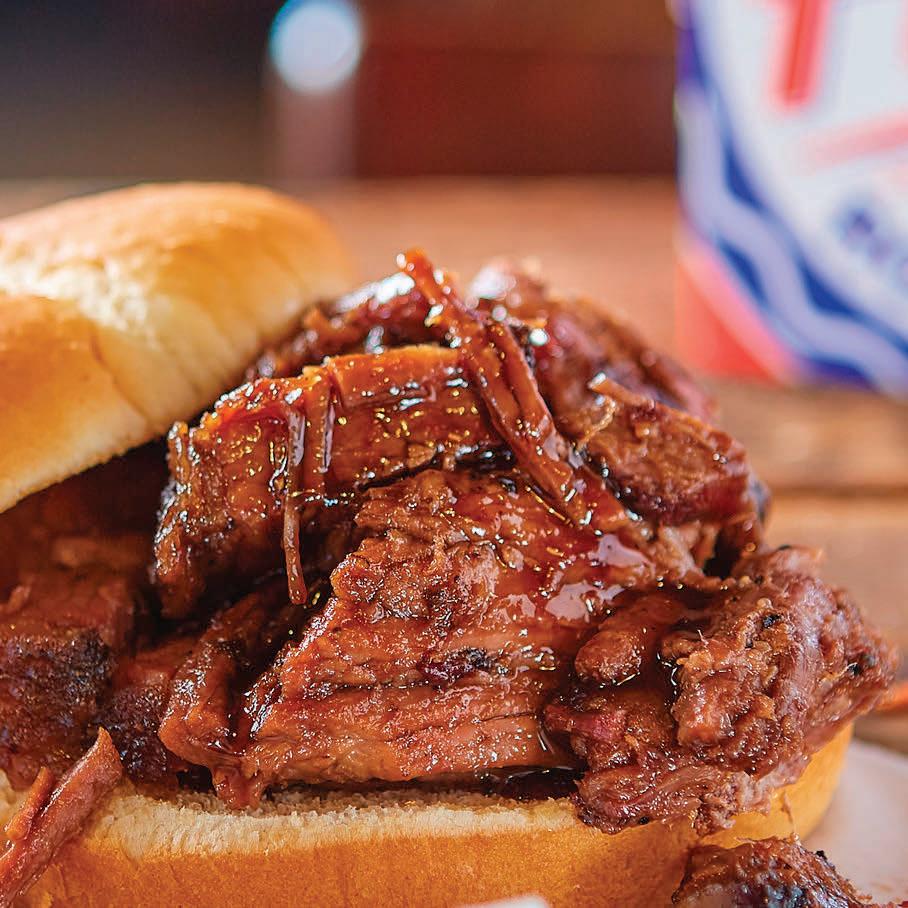
10 minute read
Winters past
By BRENT FRAZEE
I always smile when Missouri residents act like the world is coming to an end when it starts snowing.
They load up on groceries, they are afraid to drive anywhere, and they stay home as school and work are called off.
All for five inches of snow!
I hate to sound like a grumpy old man who starts his stories with the words, “Back in the day…” but I’m going to do it anyway.
I grew up in a place where winter was really winter. A five-inch snow was called
Outdoor Guide January-February 2021 Back when winter was really winter
a dusting.
Back in Illinois and Wisconsin – where I spent much of my life – snow, bitterly cold wind chills and ice were part of life. Winter was considered a friend, not an enemy.
Instead of retreating inside for weeks on end, we were out in the elements, loving life on the tundra, as we called it. I remember snowmobiling across Wisconsin lakes such as Winnebago at high speeds, the wind numbing my face. You think you know wind chill? Try doing that.
IN THE SHACK…
We often were headed for our ice-fishing shack, one of many arranged in neat rows. We followed “streets” that had been plowed on the ice and knew where to turn by following street signs. Our shack even had an address.
bullseyebaitandtackle.net

Bullseye Bait & Tackle

• Large Selection of Zoom Plastics • Live Bait - Rods - Reels • Full Line Of Tackle • Custom Spinner Baits & Jigs • Components — Over 60 Varieties
Of Blades • 160 Colors Of Silicone Skirts For Spinner
Baits & Jigs • Fishing Books • Large Selection of Crank Baits • Full Line Of Yamamoto Baits & Worms
Expert Reel Repair and Cleaning

Eelpout Festival fans land very strange-looking fish. – Brainerd Dispatch photo
There were so many shacks on the ice in those days that it looked like a small village. We had a heater in our shack and an old sofa overlooking a row of holes we had drilled in the ice. We used short icefishing rods to dip small ice jigs tipped with live bait into the cold water.
The fish were sluggish and didn’t want a lot of movement. But if the transducer of the flasher unit we were using picked up activity, we knew we had a chance of catching fish.
I remember days when we had a pile of yellow perch and walleyes on the ice by the time we were done. But the catching almost seemed secondary to the overall experience.
TALKING FISHING
Even when the fish weren’t biting, we would visit the neighbors and talk fishing. I remember one shack was decorated in an Old Milwaukee beer motif. The residents had a pyramid of empty beer cans on display and used a generator to illuminate an Old Milwaukee bar sign.
Other fishermen had shacks that we looked at as palaces. They had a loft with sleeping quarters and a downstairs with a cook stove and recliners to relax. Some even had a television set to watch the Packers.
Our group always talked about doing something like that, but we never got it done.
Once I graduated from college, I returned to that winter lifestyle when I started writing outdoors for newspapers in Illinois, Wisconsin and Missouri.
THE EELPOUT FESTIVAL
One experience stands out – the day I covered the International Eelpout Festival in tiny Walker, Minn., on the banks of Leech Lake.
The festival was the work of a marketing genius – a way to lift a lowly rough fish to royalty.
Thousands of people would descend on Walker, set up shacks and fish for the eel-like, bottom-dwelling fish. The festival was dubbed “The Greatest Party on Ice,” and it lived up to its reputation.
When they weren’t fishing, participants were taking part in ice bowling or curling, polar plunges, frozen T-shirt contests and even weddings.
Sadly, the festival had to be canceled last year because of concerns about pollution and ice conditions. Town leaders are trying to come up with a replacement party.
LOST ON THE ICE
I also remember the day we traveled by snowmobile to the middle of Mille Lacs Lake in Minnesota. We followed a guide and he took us to a spot so vast that we couldn’t see land in any direction. We caught fish from portable ice shelters, including some big walleyes, but we stayed a bit too late.
By the time we were done, daylight was fading and our guide became a bit disoriented. We took several paths, including one around some nasty looking heaves in the ice, before he finally led us to shore. It made for a good story, anyway.
I miss those days. Here in Missouri, the weather seldom gets cold enough to go ice fishing or snowmobiling for any extended period of time. But I return to North Country every once in a while to remind myself of what winter is really like.
When I do, I always think of some of my fishing friends who are relaxing on a beach somewhere in Florida. And I say to myself, “They don’t know what they’re missing.”
First Missouri bear hunt since the ‘30s
By CARL GREEN Outdoor Guide Editor
Plans are falling into place for Missouri’s return to bear hunting, now scheduled to be offered for 10 days next fall.
The Missouri Conservation Commission, meeting on Dec. 11, adopted rules for the hunt, which is intended to keep a lid on the state’s growing black bear population.
“As our black bear population continues to grow, a highly regulated hunting season will be an essential part of population management in the future,” said Laura Conlee, furbearer biologist for the Missouri Department of Conservation (MDC).
“The timing and length of the season, allowed hunting methods and a limited permit allocation, coupled with a limited harvest quota, will ensure a sustainable harvest of our growing bear population,” she added.
The state’s bear population is estimated at between 540 and 840 in an expanding range connected to larger bear populations in Arkansas and Oklahoma, both of which have bear seasons. MDC estimates the population is growing about 9 percent a year and could double within a decade without hunting.
“A bear hunting season in our state will provide opportunities for Missourians to participate in the sustainable harvest of this valuable wildlife species,” Conlee added.
ON THE SOUTH SIDE
The bears live south of the Missouri River and mostly south of Interstate 44, so the commission is creating three Bear Management Zones, and hunting permits will be limited within each zone.
Zone 1 includes the southwestern corner of the state, between the state line and I-44. The larger Zone 2 is the southeastern portion of the state, reaching as far north as St. Louis County. The largest is Zone 3, in central and western Missouri bordered by the Missouri River on the north and I-44 on the south. The remaining areas north of the Missouri River are not in a bear management zone.
It will be the first bear season in Missouri since the MDC was founded in the 1930s.
Black bears reach up to 500 pounds in Missouri, MDC reports. They were abundant before European settlement but nearly eliminated by the late 1800s because of hunting and logging. A few Missouri
Hunters may shoot one bear, and it must be a lone bear. – MDC photo

bears survived, though, and reintroductions in Arkansas also increased bear numbers in Missouri.
THE DETAILS
Dates – The season will begin the third Monday in October, which will be Oct. 18 in 2021, and cover either 10 consecutive days or until the hunt reaches its quota in each zone. Hunters must call each morning they plan to hunt to find out if the quota has been filled. Hunting hours are half an hour before sunrise to a half-hour after sunset.
Rules – Hunters may use guns or archery. Use of dogs and baiting will not be allowed, including grain, bird feed, pet food or food powder. Scents and minerals including salt are not considered bait, but mineral blocks with food additives are.
Protection –Bears may not be disturbed, pushed, harassed or taken from a den, and they must be lone black bears not in the presence of others. Hunters must wear hunter orange, make reasonable efforts to retrieve shot bears and must not leave edible portions.
Checking in – Tele-checking must be completed by 10 p.m. on the day of the harvest, and shot bears must be left intact as a field-dressed carcass or quartered until the tele-check is complete. The hunter must submit a tooth from each harvested bear within 10 days to help MDC staff with research and management.
Permits – The permit application fee is $10, and the application period is May 1-31. Applicants must be Missouri residents, applying for one of the three zones. A random drawing will be held by July 1 to select permit recipients, who may then buy a hunting permit for $25 for one bear. Hunters must 11 years or older and either have completed hunter education or be exempt by the time of the hunt.
Quotas –The harvest quota will be determined each spring by the Conservation Commission using MDC recommendations, including for 2021.
Landowners – Landowner-specific permits will not be offered, but at least 10 percent of the permits will be allocated to owners of at least 20 contiguous acres within their zones. They may register at mdc. mo.gov/landownerpermitsbefore applying for a permit.
PROS & CONS
The Conservation Commission has been holding hearings, open houses and taking comments from the public for more than a year. In July 2019, MDC compiled responses from those efforts and found that a majority said the bear hunting plan was “reasonable” but also found a majority saying the Missouri bear population should be allowed to grow.
Amanda Good, Missouri director for the Humane Society of the United States, was among those opposing the hunt.
“It’s inconceivable that a governing body with the word ‘conservation’ in it ignored the best available science by voting to open up trophy hunting on Missouri’s small bear population,” she said. “What’s even more disgraceful is the blatant disregard for the many Missouri residents who spoke out against the proposed season and the shameful catering to the extreme minority who want to exploit our wildlife for a bearskin rug.”
Among the final commenters were Kent Keene, representing the Congressional Sportsmen’s Foundation, supporting the plan, and Butler MO resident Jessica Albright opposing it.
Keene saw multiple gains from the plan.
“In addition to the truly exciting opportunity that this will provide for Missouri’s sportsmen and women, the regulated black bear hunt will allow MDC to further rely on Missouri hunters to manage the black bear population, while ensuring the longevity of the species,” he said.
Albright said hunting bears with the state’s current low bear population would be irresponsible, noting that Arkansas has about 5,000 black bears and that the October time frame would coincide with the most popular time for hiking in Missouri.
Thank You for Choosing One of Our Restaurants

Since 2008



Voted Best Ribs in America by the Food Network! Store: 314.535.4340 Catering: 314.607.2446 www.pappyssmokehouse.com









